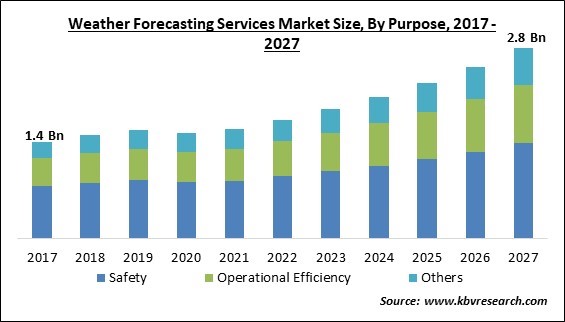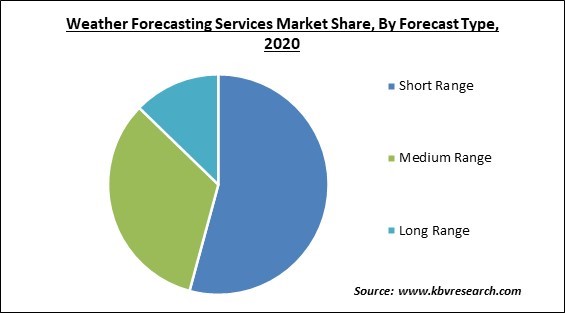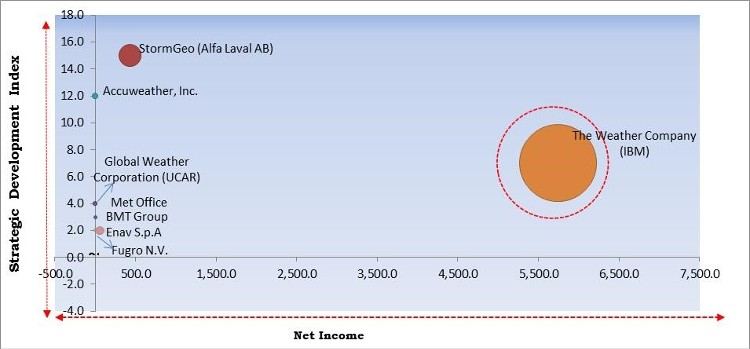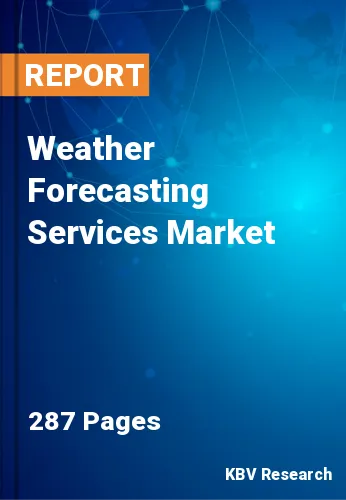The Global Weather Forecasting Services Market size is expected to reach $2.8 billion by 2027, rising at a market growth of 9.7% CAGR during the forecast period.
Weather forecasting is a type of consulting service that delivers real-time forecasts and aids in optimal day-to-day management as well as informed decision-making in a variety of industrial settings. Advanced weather notifications allow enterprises to pre-plan weather-sensitive operations, ensuring efficiency, safety, better sustainability, as well as significant cost savings. Oil and gas, construction, utilities, media, agriculture, renewable energy, shipping, and aviation are a few of the businesses that employ weather forecasting services.
Increasing power consumption and energy demand in several end-use industries have resulted in a rapid growth of this market. Numerous manufacturing enterprises are being prompted to reduce their greenhouse-gas emissions to develop green energy as a result of severe regulatory requirements. These strategies are aimed to support non-renewable energy supplies with renewable energy sources. In the near future, these factors are expected to increase the demand for weather forecasting services.
More and better-assimilated observations increased processing power, and development in the understanding of dynamics and physics have all contributed to tremendous advancements in Numerical Weather Prediction in recent decades. These developments, which have resulted in more accurate weather forecasting, would become even more important in the future. As a result, the focus in operational meteorology, oceanography, hydrology, and climatology has turned to the use of extremely complex and diversified computational methods and applications to service a growing number of users.
Due to low penetration and increasing aircraft infrastructure, developing countries have a considerable growth opportunity for weather forecasting services market. Additionally, the increased demand for concurrent weather monitoring solutions in the commercial aviation, power, and transportation sectors is likely to boost weather forecasting service demand over the forecasting period.

The COVID-19 pandemic led the world economy to a steep downfall. The outbreak of the novel coronavirus devastated various businesses across the world. In addition, countrywide lockdowns were imposed by governments all over the world in order to obstruct the diffusion of the infection. Worldwide lockdowns caused a temporary shut to almost all the manufacturing units of various goods and services, which caused a major hindrance in the supply chain. The COVID-19 pandemic has had a substantial impact on the weather forecasting services market. The suspension of the majority of the world's fleet has resulted in a significant reduction in commercial aviation flights, which provide critical weather data.
Agriculture is mostly influenced by the seasons and weathers. In addition, the farming of various vegetables, fruits, and pulses is essential and heavily relies on atmospheric conditions, especially temperature. In agriculture, weather plays a vital role, and reliable weather-based information is critical for crop production. The weather and climate risk management sector have grown even more essential in the agriculture sector during recent years as a result of climate change. It is undeniable that, in order to feed an ever-increasing population, the requirement for agricultural products has surged. Simultaneously, the requirement for agricultural management has increased, mandating careful planning based on climatic conditions. As a result, weather forecasting systems are increasingly being used by the agricultural sector to plan seasonal cropping.
Weather forecasting facilities are widely employing complex and energy-intensive devices and infrastructure. Big data includes environmental observation data, which has grown at an exponential rate in recent years. As a result, weather forecasting centers are expected to deliver integrated solutions that cover not only weather forecasters' computational requirements but also data movement and administration, as well as ownership of the whole cost of these activities. Also, the improvement of supercomputer processing capabilities is likely to facilitate the implementation of various high-resolution weather forecasts and climate models, leading to highly accurate and precise weather forecasts.
Weather forecasting models need to use real-time oceanic and atmospheric conditions to estimate future weather since weather conditions change often. Humidity, air pressure, temperature, wind speed and direction, and cloud cover are all factors in a weather forecast. Weather forecasting models cover various factors, such as proximity to water sources, geographic location, urban structures, as well as latitude and elevation. Weather conditions can be dynamic or sensitive due to the existence of multiple variables; therefore reliable predictions are made on the basis of a thorough understanding of the initial circumstances of a weather forecasting numerical model. Due to the inherent highly nonlinear weather forecast models, the practice of weather forecasting becomes complicated.

Based on Forecast Type, the market is segmented into Short Range, Medium Range, and Long Range. In 2020, the medium range segment registered a significant revenue share of the weather forecasting services market. The duration of this range varies between 7 and 10 days. Water and flood management, as well as agriculture, are some of the applications. Enterprises can also use medium-range weather information to make small operational strategic decisions. Because of the growing requirement for safety and security, the short-range segment is expected to grow significantly throughout the forecast period.
Based on Industry, the market is segmented into Energy & Utilities, BFSI, Agriculture & Forestry, Aviation, Media, Transportation, Oil & Gas and Others. In 2020, the energy & utility segment witnessed the largest revenue share of the weather forecasting market. Weather forecasts from both private meteorologists as well as government meteorologists are relied upon by utility companies as well as energy producers. They use this data to decide whether to ramp up peakers, operate their assets, or sell and purchase energy on the market. This factor is playing a major role in the growth of this segment.
Based on Organization Size, the market is segmented into Large Enterprises and Small & Medium-Sized Enterprises. In 2020, the large enterprises segment procured the largest revenue share of the weather forecasting services market. The growth of this segment is increasing due to the rising demand for precision-rich weather forecasting across various large enterprises in order to avoid accidents during operations. Moreover, large enterprises, with robust spending potential, are capable of spending more for enhanced weather predictions. This factor is driving the growth of this segment.
Based on Purpose, the market is segmented into Safety, Operational Efficiency, and Others. In 2020, the operational efficiency segment witnessed a substantial revenue share of the weather forecasting services market. Weather forecast services help various companies across different domains to plan as per the weather conditions in order to maintain operational efficiency. In addition, pre-planning and taking preparatory measures can help companies to focus more on their productivity and efficiency. Planting and harvesting can be effectively planned and executed if long-term weather events can be predicted. The growth of this segment is attributed to this factor.
| Report Attribute | Details |
|---|---|
| Market size value in 2020 | USD 1.5 Billion |
| Market size forecast in 2027 | USD 2.8 Billion |
| Base Year | 2020 |
| Historical Period | 2017 to 2019 |
| Forecast Period | 2021 to 2027 |
| Revenue Growth Rate | CAGR of 9.7% from 2021 to 2027 |
| Number of Pages | 287 |
| Number of Tables | 481 |
| Report coverage | Market Trends, Revenue Estimation and Forecast, Segmentation Analysis, Regional and Country Breakdown, Competitive Landscape, Companies Strategic Developments, Company Profiling |
| Segments covered | Forecast Type, Organization Size, Purpose, Industry, Region |
| Country scope | US, Canada, Mexico, Germany, UK, France, Russia, Spain, Italy, China, Japan, India, South Korea, Singapore, Malaysia, Brazil, Argentina, UAE, Saudi Arabia, South Africa, Nigeria |
| Growth Drivers |
|
| Restraints |
|
Based on Regions, the market is segmented into North America, Europe, Asia Pacific, and Latin America, Middle East & Africa. In 2020, North America accounted for the largest revenue share of the weather forecasting services market. The increasing growth of the regional market is owing to the increasing growth of the aviation sector across the market. The region comprises a significant aviation industry, due to which, the demand for weather forecasting solutions is increasing. Therefore, the growth of the regional market is expected to flourish.
Free Valuable Insights: Global Weather Forecasting Services Market size to reach USD 2.8 Billion by 2027

The major strategies followed by the market participants are Partnerships. Based on the Analysis presented in the Cardinal matrix; The Weather Company (IBM) is the forerunners in the Weather Forecasting Services Market. Companies such as StormGeo (Alfa Laval AB), Accuweather, Inc., Enav S.p.A are some of the key innovators in the Market.
The market research report covers the analysis of key stake holders of the market. Key companies profiled in the report include Global Weather Corporation (UCAR), Accuweather, Inc., BMT Group, StormGeo (Alfa Laval AB), Precision Weather, The Weather Company (IBM), Fugro N.V., Enav S.p.A, Met Office, and Skyview Systems Ltd.
By Forecast Type
By Industry
By Organization Size
By Purpose
By Geography
Our team of dedicated experts can provide you with attractive expansion opportunities for your business.

